There’s gold in them there hills! California’s Gold Rush is one of the most notable events of the 19th century. Word of the discovery traveled quickly, and people from all over the country made dangerous treks across the United States in the hopes of striking it rich, settling in to California Gold Rush Towns.
In January of 1848, gold flecks were discovered at Sutter’s Mill in Coloma, California. This discovery sparked the California Gold Rush as we know it, but did you know that there was an earlier discovery? In 1842, Francisco Lopez made the states first discovery while digging up wild onions in Placerita Canyon. There under an oak tree, he dug up an onion with gold flecks clinging to the roots. You can visit the location today at the historical landmark, Oak Of The Golden Dream in Newhall, California.
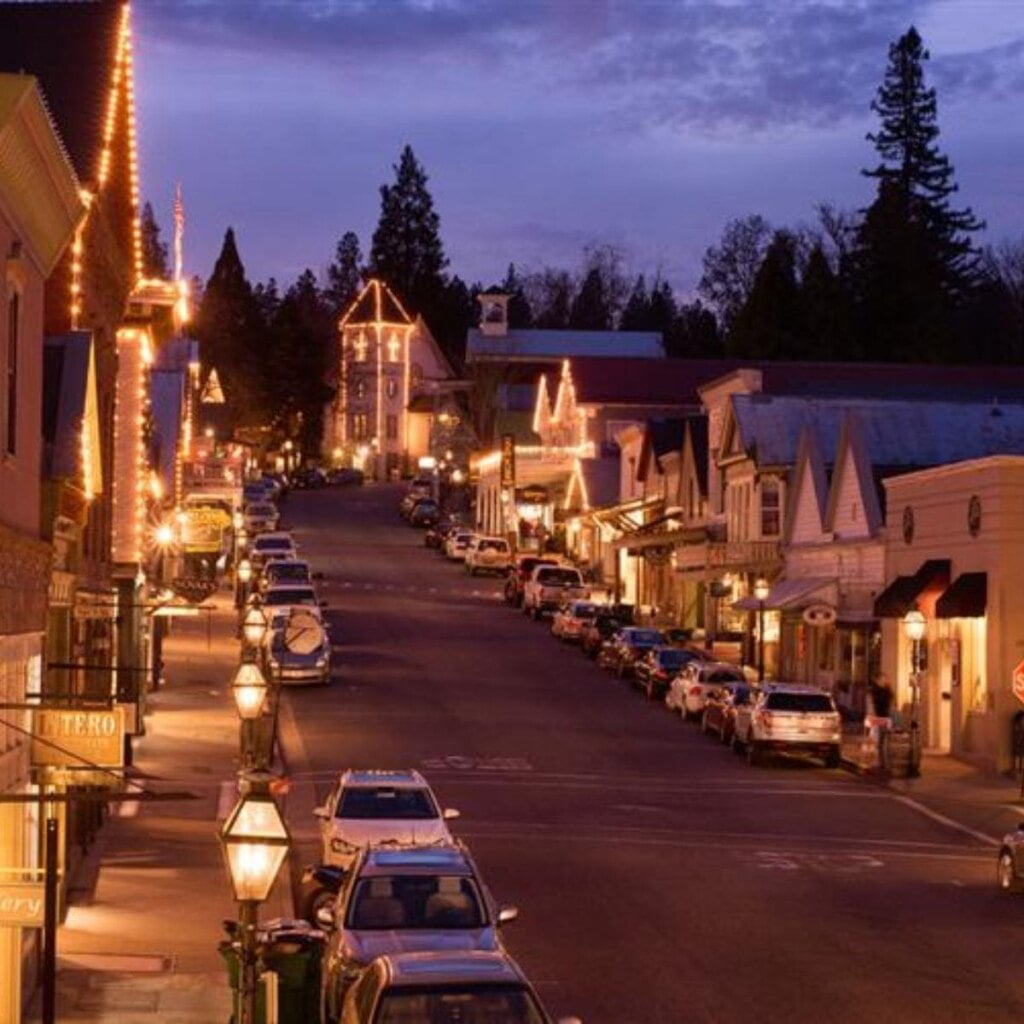
As people flooded into the state in search of gold, boom towns began popping up, and mines were created. But by 1855, the dream of striking rich had disappeared for many, as did the gold. The gold rush was over. The boom towns lingered for a bit, but many people moved on to new places and cities where bigger and better opportunities were available.
Throughout the state, there are a number of California Gold Rush Towns that are now just historic markers or ghost towns. And some are still in business today! Here, we’ll share some of the best California Gold Rush Towns, plus some places where you can still go looking for gold.
The Best California Gold Rush Towns
Angel’s Camp
Angel’s Camp was first settled in 1848 and by 1849, had grown to 300 miners. Although they weren’t as successful as other mining towns, their were a a good trading center and that kept the city in business. They received another round of mining success when gold bearing quartz was discovered. The town today retains it’s gold rush era charm and they host an annual frog jump…Mark Twain wrote a short story called “The Celebrated Jumping Frog of Calaveras County” based on a story that he heard at the Angels Hotel in 1865. Because of this, Angel’s Camp is sometimes called Frogtown.
Angel’s Camp Highlights
- Angels Camp Museum: See one of the largest collections of carriages and wagons in the Nation plus gold rush history, pan for gold, and try a human frog jump.
- Altaville Schoolhouse: One of the best preserved schoolhouses in the state, built in 1858 of brick, and was in use until 1950.
- Greenhorn Creek Trail: Hiking trail that passes historic landmarks and points of interest includeing early settler sites and mining remains.
- Angels Hotel: Historic site where Mark Twain visited
- Angels Camp Historic Walking Tour & Driving Map
Auburn
Gold was discovered in Auburn in 1848, with large deposits located at Rich Flat and near Old Town. Auburn was the site of the first gold discovery in Placer County. Auburn was well located, connecting Sacramento to gold camps, and had a direct route to San Francisco. Auburn became the county seat for Placer County in 1851. Later, when surrounding boomtowns were abandoned, Auburn continued to thrive.
Auburn Highlights
- Old Town Auburn: Visit Old Town Auburn for unique shopping destinations, historic sites, museums, casual and fine dining, and a number of services.
- Old Town Auburn Post Office: This is the oldest operation post office west of the Mississippi!
- Gold Rush Museum: Captures local history of the Gold Rush Era and features an indoor gold panning stream, mining tunnel exhibit, operating stamp mill, and many hands-on exhibits. And admission is free!
- Bernhard Museum Complex: Established in 1851 as Traveler’s Rest Hotel, the Bernhard House is a preserved living history museum featuring a carriage barn with 19th century wagons, a furnished Victorian era farmhouse, the original gold rush era inn, a restored winery that dates back to the 1870s, and more!
- Gold Country Medical History Museum: Located on the site of the first Placer County Hospital established in 1855, the restored Victorian home turned museum features medical-themed exhibits that include tools and artifacts used in the medical and dental fields from the mid 1800s to mid 1900s. You can even see some of the quackery devices, glass eyeballs, and an authentic doctor’s buggy.
- Joss House: The original Joss House served as a place of Buddhist and Confucianist worship, a place to educate children, and a hostel for travelers. It is a historic monument that preserves the legacy of Chinese contributions during the Gold Rush era.
Bodie Ghost Town
Bodie Ghost Town is a California State Historic Park that preserves a genuine California gold rush town. At its peak, Bodie had a population of nearly 10,000 people. It was known as an area with one of the richest gold strikes in the state, but was also one of the toughest most lawless mining camps. Bodie was an active town during the 1860s and 1870s, reaching boomtown status in 1877. The town had more than 2,000 buildings. But by 1881, Bodie’s popularity was on a fast downhill and by 1886, only about 1,500 people remained. Two separate fires eventually destroyed the majority of the buildings in the town. Bodie was designated a National Historic Site and State Historic Park in 1962. What remains has been preserved for visitors to explore in a state of arrested decay, with much of the interior remaining as they were left.
Bodie Highlights
- The Standard Mill
- Bodie Methodist Church
- The Sawmill
- Bodie Jail
- Stuart Kirkwood Livery Stable
- Bodie Bank
- Sam Leon Bar & Barber Shop
- Bodie Firehouse
- Boone Store & Warehouse
- Bodie Schoolhouse
- Swazey Hotel
- Dechambeau Hotel and I.O.O.F. Building
- Miners’ Union Hall and Museum
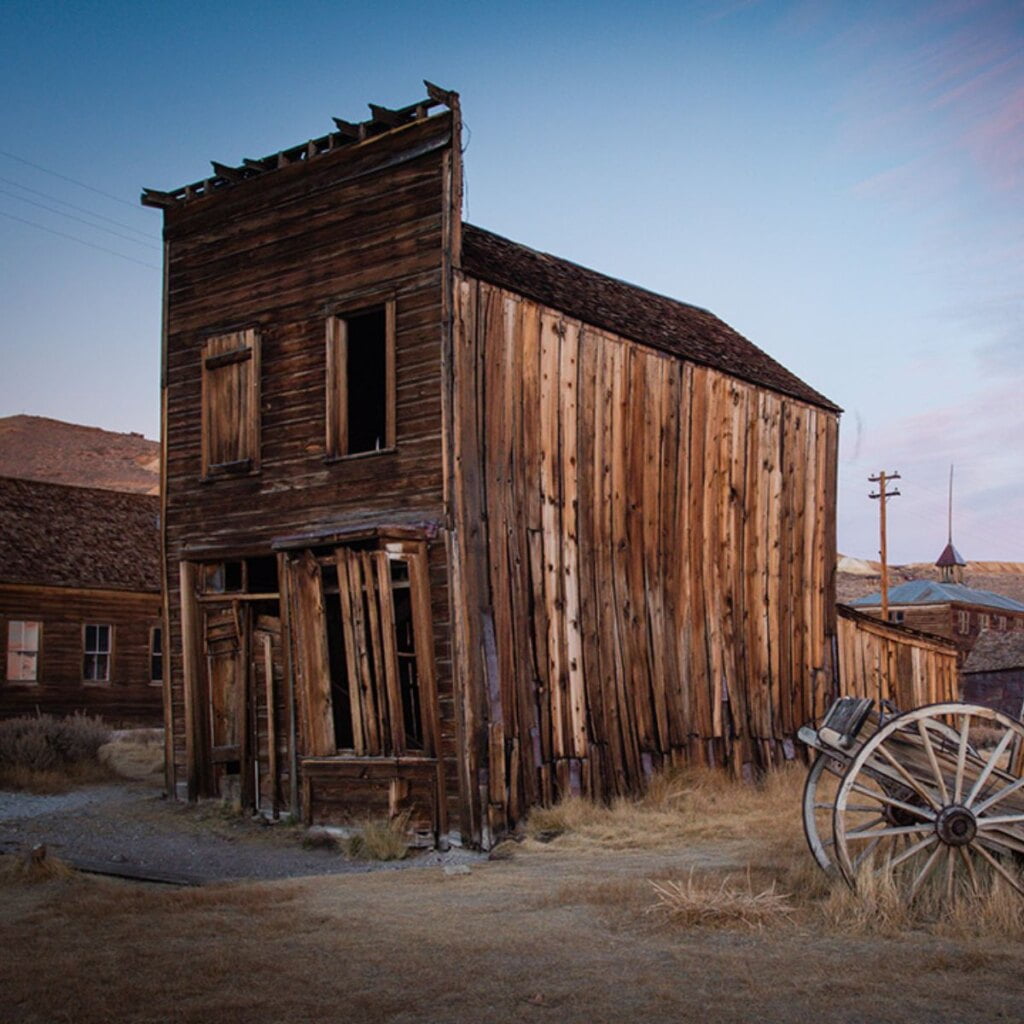
Columbia State Historic Park
Columbia State Historic Park was once known as the Gem of the Southern Mines, the town mined over one billion dollars (today’s value) worth of gold between the 1850s and the 1870s and at one point, was California’s second largest city. Like Auburn, the town of Columbia managed to survive the Gold Rush era and became a state historic park in 1945. Columbia today is an active town that has preserved its historical past and offers a glimpse into life during the Gold Rush.
Columbia Highlights
- Many preserved historic buildings
- Stagecoach rides
- Historic saloons, schoolhouse, and cemetery
- Daily town tours
- Gold Rush Days every second Saturday of the month
- Columbia State Historic Park Museum
- Columbia Diggins 1852: Annual reenactment of an 1852 Gold Rush Tent Town
Folsom
The city of Folsom was founded as Granite City and most of the population was gold miners. Within Folsom City limits were three other gold rush era towns known as Mormon Island, Salmon Falls, and Prairie City. All that is left of these three towns are Historical Landmark markers. A few remains of Salmon Falls can be seen at low water levels, including remnants of the old Salmon Falls Bridge. Folsom itself thrived after the Gold Rush and today, is best know for being the home of the state’s second oldest prison, Folsom State Prison. Folsom State Prison opened in 1880 and was known for its harsh conditions.
Folsom Highlights
- Folsom State Prison
- Explore Folsom Historic District: Take the walking tour to learn about the historic buildings
- Folsom Powerhouse State Historic Park: Built in 1895, you can explore vintage generators, the control switchboard, and learn how water powered electricity in the early days
- Walk the Johnny Cash Trail
- Folsom History Museum and Pioneer Village
- Folsom Railroad Museum
- Folsom Lake
Grass Valley
Grass Valley was an important site during the gold rush. Gold was discovered here at Gold Hill in 1850 and three prominent mines were established in the area – Empire Mine, Idaho-Maryland Mine, and North Star Mine. These went on to become some of the states richest mines. Empire and North Star mines produced the most gold in the country between 1900 to 1925, and by 1938, the Idaho-Maryland mine was the second largest producer of gold in the country.
Grass Valley Highlights
- Empire Mine State Historic Park: 10791 East Empire Street – Empire Mine was in operation for over 100 years, extracting 5.8 million ounces of gold. The mine operated until 1956. You can explore old mine buildings, homes, gardens, abandoned mine shafts, and 14 miles of hiking trails.
- North Star House: A historic Julia Morgan Home from the gold rush era built on a 14-acre portion of the North Star Mine site.
- Historic Downtown Grass Valley
- Holbrooke Hotel
Jackson
Jackson is the site of one of the deepest gold mines in the world at 5,912 feet deep! Kennedy Gold Mine produced over $34 million in gold and operated until 1942. Today you can tour the historic mine from March through October and learn about the history of the mine. Jackson maintains its historic gold rush era charm and every year on the last weekend in April, head to Main Street for the Kit Carson Mountain Men Days of 49 Wagon Train for a parade, music, gold rush era activities, and more.
Jackson Highlights
- Historic Main Street – See Civil War era storefronts, antique shops, art galleries, dining, and more.
- Kennedy Gold Mine
- Argonaut Mine Historic Site
- Amador County Museum
Julian
Julian was the home of what’s known as California’s second gold rush. Located in Southern California, gold was discovered here in 1869 and mining operations began. Julian had the most successful gold mine of its time and operated until the early 1900s. Today, visitors can take guided tours of Eagle Mining Company to explore the tunnels and learn about mining operations. Julian is an old-timey small town that is famous for its apples, and this is a popular destination for apple picking every fall. There are several orchards and many locations offer living history programs to immerse visitors in the lifestyle of the late 1800s and early 1900s.
Julian Highlights
- The Eagle Mining Co.
- Julian Pioneer Museum
- Julian Jail – Historic structure on 4th and C Street in Julian
- Fort Cross Old Timey Adventures
- Julian Farm & Orchard/Julian Mining Co.
- Julian Contry Christmas
- Annual Fourth of July Parade
- Apple Season
Mariposa
Founded in 1849, Mariposa is one of the southernmost gold rush towns along the Golden Chain Highway, at the junction of HWY 140 and HWY 49. 61 buildings in Mariposa are on the Federal Register of Historical Places including the Fremont Adobe, the Capitol Saloon, the Mariposa Meat Market, and the Bogan Building.
Downtown Mariposa is a few short blocks, but it’s packed full of historic Gold Rush era charm with unique shops and restaurants.
Mariposa Highlights
- Mariposa Museum & History Center: Indoor and outdoor exhibits including mining machinery and equipment, an operational stamp mill, historic buildings like the Original Gazette Building, a one room miners cabin, Yosemite Valley Railroad exhibit, and Native American exhibits.
- California State Mining & Mineral Museum: See the Fricot “Nugget”, a 13.8 pound mass of crystallized gold, walk through a mine tunnel, learn about the gold rush era, and the history of mining and minerals.
- Mariposa Courthouse: Built in 1854, it’s the oldest continuously operating courthousewest of the Rocky Mountains.
Murphys
Murphys started as a trading post and gold mining operation in 1848. The Murphys were part of the first group of immigrants to successfully bring wagons over the Sierra, and according to reports, the Murphy Brothers claimed $2 million in gold ore in a single year. Murphys was a bustling gold rush town that stood the test of time. Miners and gamblers were replaced by families, and today, Murphys retains its historic gold rush charm infused with modern sophistication.
Murphys Highlights
- Murphys Old Timers Museum: Learn about the history of Murphys and its gold rush days
- Murphys Main Street: Historic buildings, shops and restaurants
- Murphys Irish Day: Third Saturday in March every year celebrates the towns Celtic heritage
- Murphys Open House: First Friday in December, welcomes in the holiday season
- Murphys Historic Hotel: Open since 1856 and has been visited by Mark Twain, Black Bart, and Ulysses S. Grant
Nevada City
Nevada City claims to be California’s best preserved gold rush town. The quaint town is surrounded by forest with Deer Creek flowing through the center of town. The area was first settled in 1849 when prospectors moved in to search for gold. The Downtown area is full of historic buildings to explore, and there are several points of interest in the city.
Nevada City Highlights
- Historic Firehouse No. 1 Museum: Built in 1860 features mining artifacts and relics from the Donner Party, Native American exhibits, and pioneering displays
- Historic Firehouse No. 2: Built in 1860, one of California’s oldest continuously used firehouses
- Nevada County Narrow Gauge Railroad Museum: Preservation of narrow gauge railroad era history and artifacts
- Miners Foundry Cultural Center: Dates back to 1856, the first Pelton Wheel was built here in 1879
- Nevada Theatre: The oldest theatre building in the west that is still operating as a theatre, built in 1865
Placerville
Placerville was the Western terminus of the Overland Trail throughout the 1850s and in 1854, it was the third largest town in California. Settled by miners and merchants, the town and surrounding camps had their fair share of crime. In 1849, three criminals were convicted and hanged from an oak tree in town, earning it the nickname, Hangtown. The tree no longer stands, but you can visit the bar on Main Street named The Hangmans Tree, where the stump of the tree is hidden in the cellar. Much of the city was destroyed by a fire in 1856, but the Comstock silver strike brought new life to the area. If you visit Placerville, try Hangtown Fry — a meal made with eggs and oysters, originally requested by a hungry miner who could finally afford a meal other than canned beans.
Placerville Highlights
- Downtown Placerville
- Hangtown Wagon Train Days: Celebrates the towns gold rush era wild west days every June
- Placerville Museum in the Historic Fountain and Tallman Soda Works Building: Features a number of displays including gold rush era history and artifacts
- El Dorado County Historical Museum: Preserves the county’s history with exhibits about Native Americans, the gold rush, the logging and lumber industry, transportation, and historical figures
- Historic Cary House Hotel: Built in 1857 and known as the Jewel of Placerville, the hotel features original brickwork and antique furnishing and is said to be one of the areas most haunted spots
Sacramento
Although is was established before the gold rush, Sacramento was an important city center for prospectors traveling into the area. Not to mention, the discovery of gold was right outside the city in Coloma on the American River. Sacramento also has an extensive collection of historic buildings dating back to the 1800s. You can even enjoy a little living history in Old Town with guides reenacting the gold-rush era lifestyle. Plus, visit Sutter’s Fort State Historic Park to see the site of the first European settlement in the central valley. The founder, John Sutter was also the owner of the mill where gold was first discovered.
Sacramento Highlights
- Old Sacramento: 53 historic buildings and 28 acres preserving the past complete with wooden sidewalks, horse-drawn carriages, and Mississippi style riverboats
- California State Railroad Museum: Most comprehensive collection of trains and related artifacts in North America
- Sacramento History Museum: Learn about California history, the Gold rush, newspaper history, and agriculture
- Sutter’s Fort State Historic Park: First permanent European colonial settlement is California’s Central Valley, established in 1839
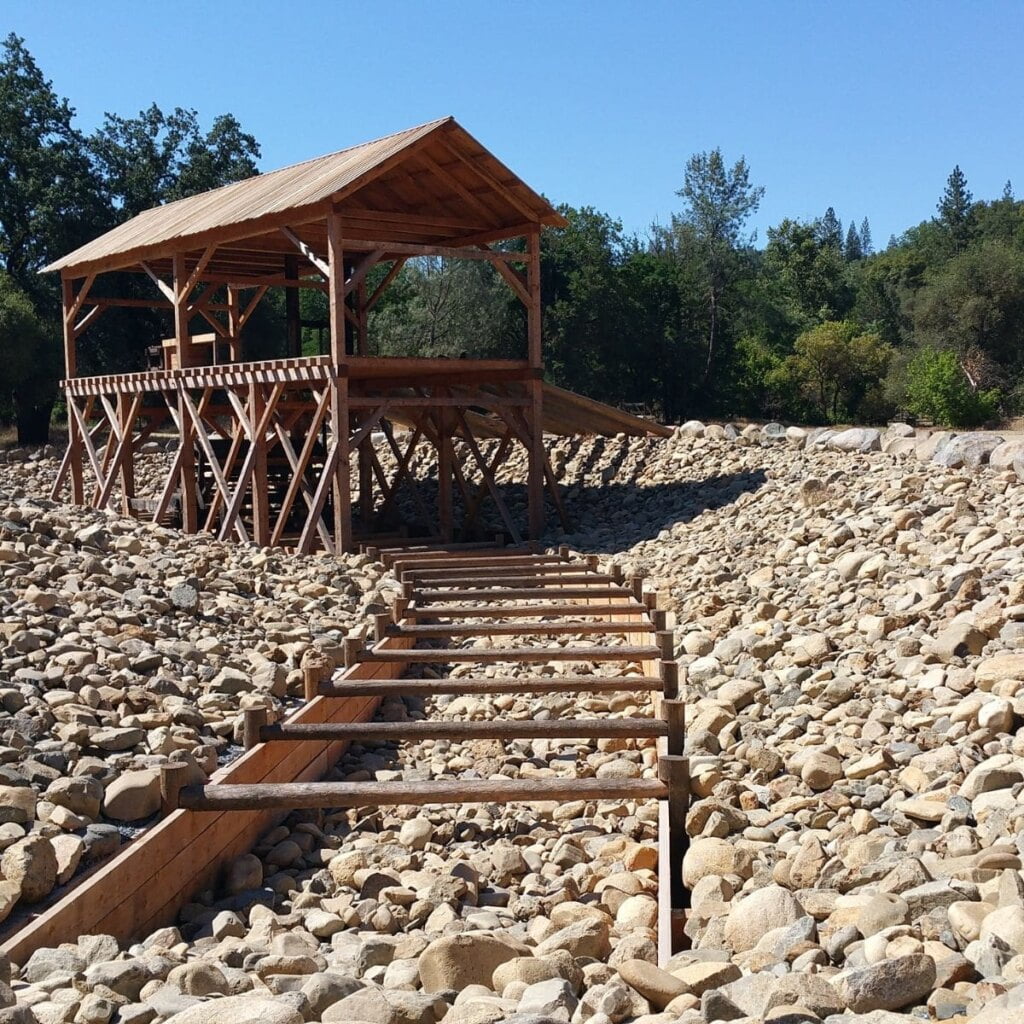
Sierra City
Sierra City is the northern most point on California’s Golden Chain Highway and one of the first mining camps in California. Nestled next to the North Yuba River, settlers moved in around 1850 in search of gold. The camp was destroyed by an avalanche during the very first year, but people stuck around and rebuilt. And it’s a good thing they did – the largest gold nugget was in California was found here, weighing in at 106 Troy pounds. That’s about 87 regular pounds! The Monumental Nugget was discovered in 1869 and you can see a life size replica of it at the Kentucky Mine Museum right here in Sierra City. The Sierra Buttes mine near Sierra City operated for 80 years.
Sierra City Highlights
- Kentucky Mine Historic Park & Museum: See a replica of the Monumental Nugget, experience a day in the life of a gold rush miner, and see an operating stamp mill.
- Loves Falls: A quick and easy hike to a bridge and a waterfall that are part of the Pacific Crest Trail.
- Bassett’s Station: Open seasonally, Bassett’s Station is a cafe, store, and motel that has been serving the town since 1865.
- Sierra Buttes Lookout: Climb to the top of the 8,587-foot high Sierra Buttes, a popular hiking spot since the 1850s and was once a 4th of July tradition. Today, there is a fire lookout there with steep aluminum stairs that you can climb to the top.
Sonora & Jamestown
These two gold rush towns are just three miles apart on Highway 49. Here in Jamestown, you can still wade into the American River and pan for gold just like the early prospectors did, and Woods Creek flows right through town.
Sonora has retained it’s old time charm, with historic buildings downtown. In addition to its gold rush history, more than 300 films and tv shows have been filmed here. Visit the local Walk Of Fame to see medallions marking the areas film heritage.
Jamestown & Sonora Highlights
- Railtown 1897 State Historic Park: Take a ride through Gold Country on a historic steam or diesel locomotive.
- Gold Prospecting Adventures: Step into an 1849 gold mining camp and pan for your very own gold.
- National Hotel & Restaurant: Established in 1859, it has been in continuous operation ever since. The original back bar is still in use with a working 1881 cash register, there is a gold mine shaft near the garden courtyard, and the hotel includes occasional visitors from the resident ghost.
- Tuolumne County Historical Society: See exhibits and collections about the areas history from the Gold Rush through modern times.
- Veterans Memorial Military Museum: Remembers Tuolumne County Veterans from WWI to present.
- Walk Of Fame: See medallions marking the film and television history of the area.
Sutter Creek
Named for John Sutter, the man behind the mine where gold was discovered, Sutter Creek dates back to 1846. In the early days, Sutter Creek served as a supply center for the surrounding mines. After the gold rush, quartz mines were operated until the 1950s. There are still plenty of historic buildings to see downtown with a variety of shops and restaurants and you can learn more about them if you take the walking tour. Sutter Creek is also very close to surrounding gold rush towns Jackson, so you can head over and tour Kennedy Gold mine, one of the deepest gold mines in the world.
Sutter Creek Highlights
- Sutter Creek Gold Mine Trail: A trail to visit each of Amador County’s gold mines.
- Knight Foundry: Sutter Creek’s Industrial Jewel, established in 1873, it’s the last water-powered foundry and machine shop in America.
- Kennedy Gold Mine: Famous for being one of the deepest gold mines, coming in at 5,912 feet deep.
- Monteverde Store Museum: Established in the 1800s, this is a well preserved general store from the gold rush era.
- Miner’s Bend Park: A public park with historic displays and information about the gold rush including artifacts and plaques.
- Historic Sutter Creek Schoolhouse: The original 1856 structure was destroyed by a fire, and the structure standing today is the brick schoolhouse built to replace it in 1870.
Where To Find Gold In California
Most gold rush era towns have some sort of tourist attraction, museum, or park that offers tours and gold panning experiences. Beyond that, there are some places that you can still pan for gold on public lands.
Be sure to read up on any gold panning regulations including designated area and types rockhounding tools allowed. For instance, many areas only allow gold panning using the “hands and pans” method. Tools and equipment often may not be used in rockhounding, except gold pans.
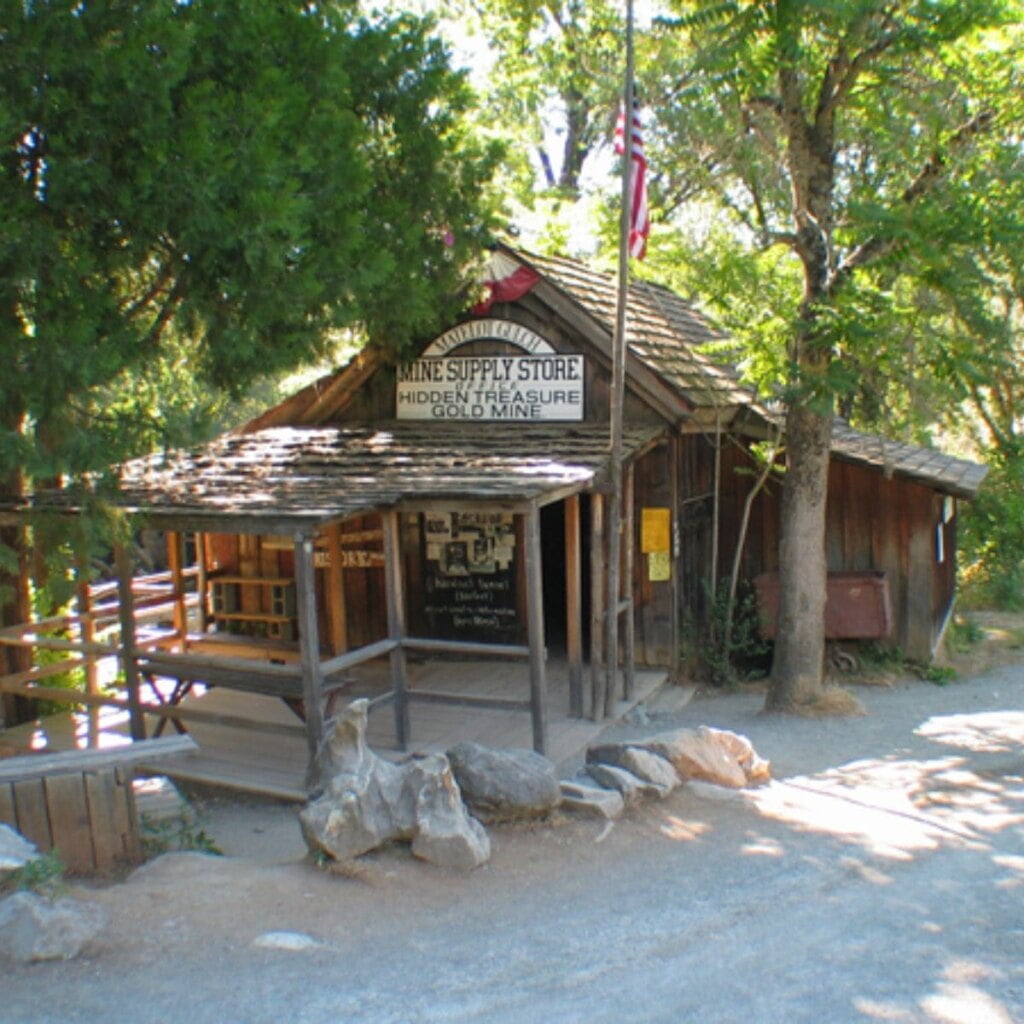
The American River
The American River is still open to public prospecting. You can explore the shores along the river and give gold panning a go for yourself. You can also try using metal detectors.
Coloma
The majority of the town of Coloma is preserved as Marshall Gold Discovery State Historic Park, and you can learn how to pan for gold and try it out yourself here. Alternatively, registered guests in private campgrounds can pan for gold as well.
Columbia State Historic Park
Columbia State Historic Park is a living history destination where you are immersed in the gold rush era. A few mines are open for visitors to explore and they offer gold panning lessons.
Downieville
Mining began in Downieville in 1849 and is still one of the most active spots for placer mining in California. Considered the least changed of California’s gold rush towns, you can see plenty of historic buildings here, and the public can pan for gold behind Gallows Café & Pizzeria.
Jamestown
Step into the South Fork of the American River just like miners of the Gold Rush days. Jamestown has several shops in town that sell all the supplies that you need so that you can search for gold just like the old prospectors.
Julian
Visit Eagle Mining Co. in Julian to explore a real 1870s mining operation and give panning for gold a try for yourself.
Kern River
You can explore Keyesville Recreational Mining Area and practice prospecting for yourself along this 400-acre stretch of the Kern River. Then head to Greenhorn Creek to to see where they found gold during the gold rush.
Mokelumne River
Head to Pine Grove and visit Roaring Camp Mining Company. Here on the banks of the Mokelumne River is an old miners camp with a real gold mine where you can try searching for gold by panning, sluicing, and dry washing.
Plumas County
In Plumas County, you can pan for gold on any public National Forest Land that is not staked. Keep an eye out for signage. If you need lessons and information, Golden Caribou Mining Association offers lessons to first timers and has supplies available to purchase. Call (530) 283-5141 for info. You can also try joining the Advanced Geologic’s Gold Prospectors Club for access to claims.
South Yuba River
South Yuba River State Park allows gold panning with the hands and pans method. Some of the best places to try outside of that are in Bridgeport, Edwards Crossing, and Washington. Head up to Middle Yuba River at Oregon Creek, too. You won’t have to worry about claimjumping here as these are all public areas along the river. If you don’t find gold, no worries, there are plenty of beautiful swimming holes here in this wilderness area, so you can make the most of your time on the river.
More Places To Pan For Gold
- Angel’s Camp – Gold Rush Originals
- Auburn State Recreational Area – Metal detectors prohibited
- Barton Flats – San Gorgonio Recreation Area
- Big Bear Lake Recreation Area
- Butte Creek Forks Recreation Area – Designated areas, permits required
- Kern River – Keysville Recreational Mining Area
- Lake Arrowhead – Green Valley Lake Recreation Area
- Lytle Creek – Cajon Pass Recreation Area
- Malakoff Diggins State Historic Park – Humbug Creek from Chinese Gardens to Relief Hill Bridge. See a near-complete gold rush ghost town, a packed mining museum, and 20 miles of hiking trails that pass everything from a historic cemetery and schoolhouse, plus an underground hike that leads to an abandoned gold mine
- Merced River – Merced River Recreational Area near Briceburg, McCabe Flat Campground, Cable Rock Day Use Area.
- Oroville – Feather River
- Randsburg – Near the Mojave Desert
- San Bernardino National Forest
- San Jacinto – Santa Rosa Mountains Recreation Area
- Santa Clarita – Dry creek beds and hillsides in the area
- Swasey Recreation Area – Areas cannot be claimed, open to public, sluicing in Clear Creek
- Trinity River – Wild and Scenic Area from Lewiston to Pigeon Point
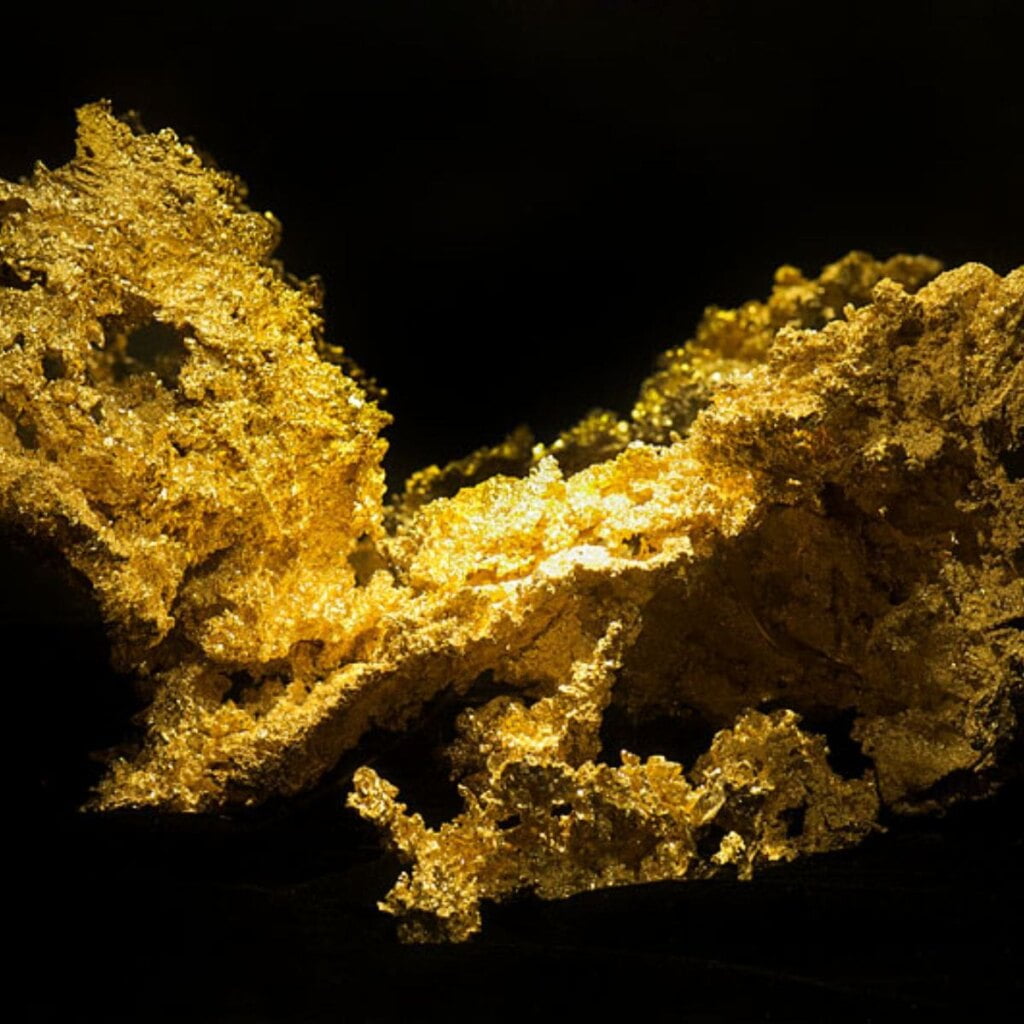
Highway 49
Highway 49, or State Route 49, runs north-south along the Sierra Nevadas. It is known as the Golden Chain Highway, connecting many historic gold rush era communities. Its southern terminus is at an intersection with SR 41 in Oakhurst, California and ends at its northern terminus in Vinton, CA at SR 70. Highway 49 opened in 1934. Here are some of the gold rush mining towns along and near Highway 49. Note that some may no longer exist as “towns” but most can still be found on maps:
- Angel’s Camp
- Amador City
- Auburn
- Bidwell’s Bar
- Blue Tent
- Camptonville
- Carson Hill
- Chinese Camp
- Coloma
- Columbia
- Condemned Bar
- Coulterville
- Diamond Springs
- Dog Town
- Downieville
- Dutch Flat
- El Dorado
- Fiddletown
- French Corral
- French Lake
- Gold Run
- Grass Valley
- Horseshoe Bend (now submerged under Lake McClure reservoir)
- Jackson
- Jamestown
- Mariposa
- Michigan Bar
- Michigan Bluff
- Middle Bar
- Mokelumne Hill
- Mormon Bar
- Mormon Island
- Mount Ophir
- Nevada City
- North San Juan
- Oakhurst
- Placerville
- Plymouth/Pokerville
- Portuguese Flat
- Prairie City
- Red Dog
- Ridley’s Ferry
- Rough and Ready
- San Andreas
- Shingle Springs
- Sierra City
- Sonora
- Sutter Creek
- Tuolumne City
- Weaverville
- Yankee Jims
- You Bet
Orange County Places to Pan for Gold for Recreation
Here are places in Orange County and nearby where you can pan for {fools) gold while learning about mining and how to pan for gold.
- Knott’s Berry Farm
- Irvine Ranch Outdoor Education Center
- Irvine Regional Park (seasonal)
- Julian, CA
- Gold Rush Mining Co (Big Bear, CA)
Biggest Gold Nuggets Found in California
These are some of the biggest nuggets found in California including one found in 1977 and another in 2014.
- Carson Hill Nugget | 195 Troy Pounds | 1854 – Discovered at Carson Hill Creek in Calaveras County.
- Monumental Nugget | 106 Troy Pounds | 1869 – Discovered at the Sierra Buttes Mine in Sierra County.
- Wood’s Creek Nugget | 133 Pounds | 1848 – Discovered at Wood’s Creek, Tuolumne County.
- Magalia Nugget | 54 Pounds | 1859 – Discovered in Magalia, CA located in Butte County.
- Knapp’s Ranch Nugget | 50 Pounds | 1851 – Discovered near Knapp’s ranch in Toulumne County.
- Holden Chispa | 18 Pounds | 1850s – Holden’s Gardens in Sonora in Sonoma County.
- Montezuma Nuggest | 18 Pounds | 1853 – Montezuma Tent in Toulomne County.
- Fricot Nugget | 13 Pounds | 1865 – Discovered at the Grit Mine at Spanish Dry Diggin’s in El Dorado County.
- Mojave Nugget | 156 Troy Ounces | 1977 – Found by metal detector in Mojave desert in Kern County, near Randsburg, California in the Stringer Mining District.
- Butte Nugget | 75 Troy Ounces | 2014 – Found by metal detector somewhere in Butte County.
